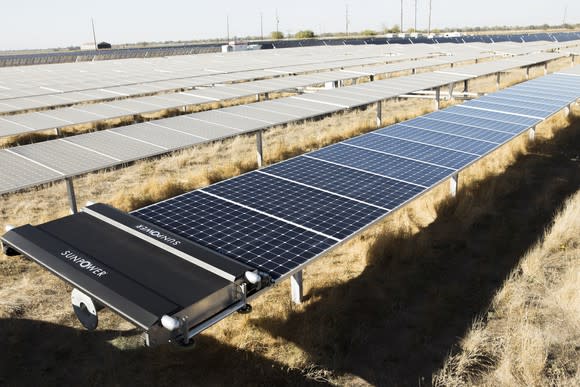How SunPower's Making Itself Shine
The biggest risks facing SunPower Corporation (NASDAQ: SPWR) in 2017 and early 2018 were the company's bloated balance sheet and continuing losses. At the beginning of 2017, the company had $1.6 billion in debt and a $300 million convertible debt maturity looming in 2018, and was affected by uncertainty in the overall solar market. But as 2018 unfolds, we're getting a better idea of what the long-term balance sheet will look like, and it isn't as bad as one might think.
SunPower's sale of 8point3 Energy Partners (NASDAQ: CAFD) and the announced sale of residential-lease assets will simplify and strengthen the balance sheet. Here's a look at how the company will look after these major sales.

Image source: SunPower.
SunPower's transformative asset sales
There are two big asset sales that SunPower has in the works right now. The first is the sale of 8point3 Energy Partners, which will net SunPower about $350 million in cash when completed sometime this summer. The other is the sale of 45,000 residential leases, which will bring in about $200 million of cash proceeds and allow the company to sell or deconsolidate $436 million of debt currently on the balance sheet.
With the 2017 year-end balance sheet as a starting point, here is an estimate of what the balance sheet would look following the asset sale:
Line Item | Value on 12/31/17 | Value Following 8point3 and Lease Sale |
|---|---|---|
Cash | $478.8 million | $728.8 million |
Convertible debt | $1,116.1 million | $816.5 million |
CEDA loan | $28.5 million | $28.5 million |
Nonrecourse debt | $456.3 million | $20.3 million |
Net debt | $1,122.1 million | $136.5 million |
Data source: SunPower's 2017 10-K and Q4 2017 earnings call. Calculations by author.
By summer, SunPower could be nearly net-debt-free, if it doesn't increase spending in any other way. That means that based on 2017 adjusted EBTIDA of $189.7 million and a market cap of $1.07 billion, the company has an enterprise value/EBITDA of just 6.3.
The EV/EBITDA ratio is only a snapshot of value, and we need to consider that adjusted EBITDA fell 39.2% in 2017 and that management only guided to "positive EBITDA" in 2018. But if SunPower's business shows improvement, the stock could be a good value after asset sales are completed.
Opening up options for the future
The numbers above are rough estimates and may vary depending on what SunPower chooses to do with its cash. But they imply that options will start opening up.
One move SunPower could make in 2018 is to increase manufacturing in areas where it's cost effective to do so. P-Series solar panel production is already growing at a China joint venture from about 700 megawatts of capacity today to as much as 5 gigawatts in the next five years. The company also has a 641,000-square-foot facility in the Philippines that could serve as an expansion hub for next-generation solar cell manufacturing. Weakness in the balance sheet and a two-year buildout timeline made expansion difficult over the past year, but now could be the time to get aggressive in the high end of the market.
Another intriguing option: expanding P-Series manufacturing in its Mexico plant, in the booming Middle East market, or even in the U.S. Building capacity in P-Series costs only $0.05 to $0.10 per watt, and production uses commodity cells from other manufacturers, so this could be a good growth option in the popular power-plant market.
The other growth opportunity I expect SunPower to push in 2018 is energy storage. The company says it has a $60 million pipeline of U.S. commercial-storage projects, but it can make that business much bigger. Storage is starting to be economical with residential solar and can be a standard with commercial solar installations. Investing in both capabilities, such as software, and manufacturing capacity will be key in 2018.
A cloud is lifting over SunPower
As the balance sheet becomes less of a risk for SunPower, it should free up the company to invest in growth opportunities and allow investors to see the underlying value in the company. If SunPower can increase its adjusted EBITDA, I think the stock could be a big winner for investors, so keep an eye on the company's execution in 2018.
More From The Motley Fool
Travis Hoium owns shares of 8point3 Energy Partners and SunPower. The Motley Fool has no position in any of the stocks mentioned. The Motley Fool has a disclosure policy.

 Yahoo Finance
Yahoo Finance 